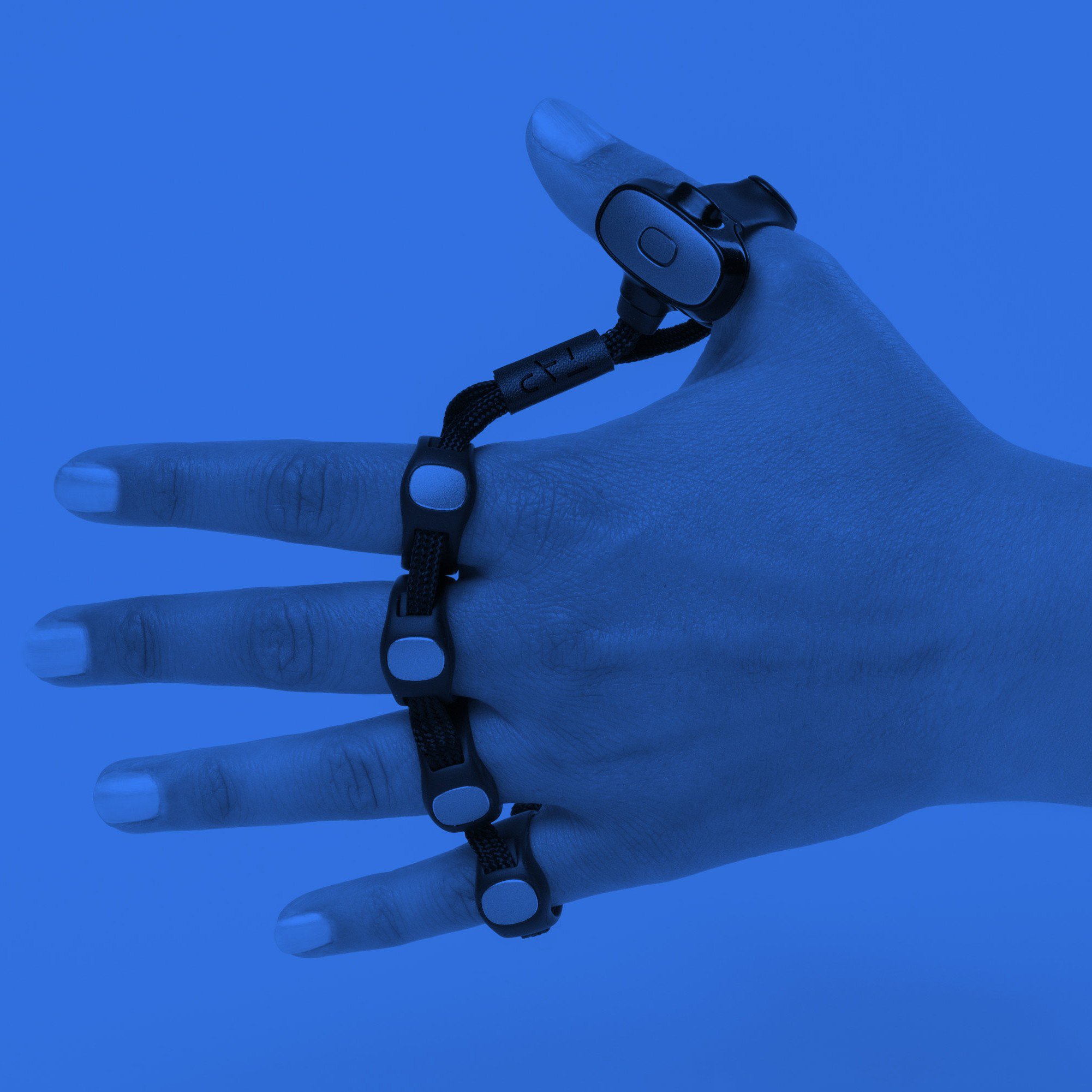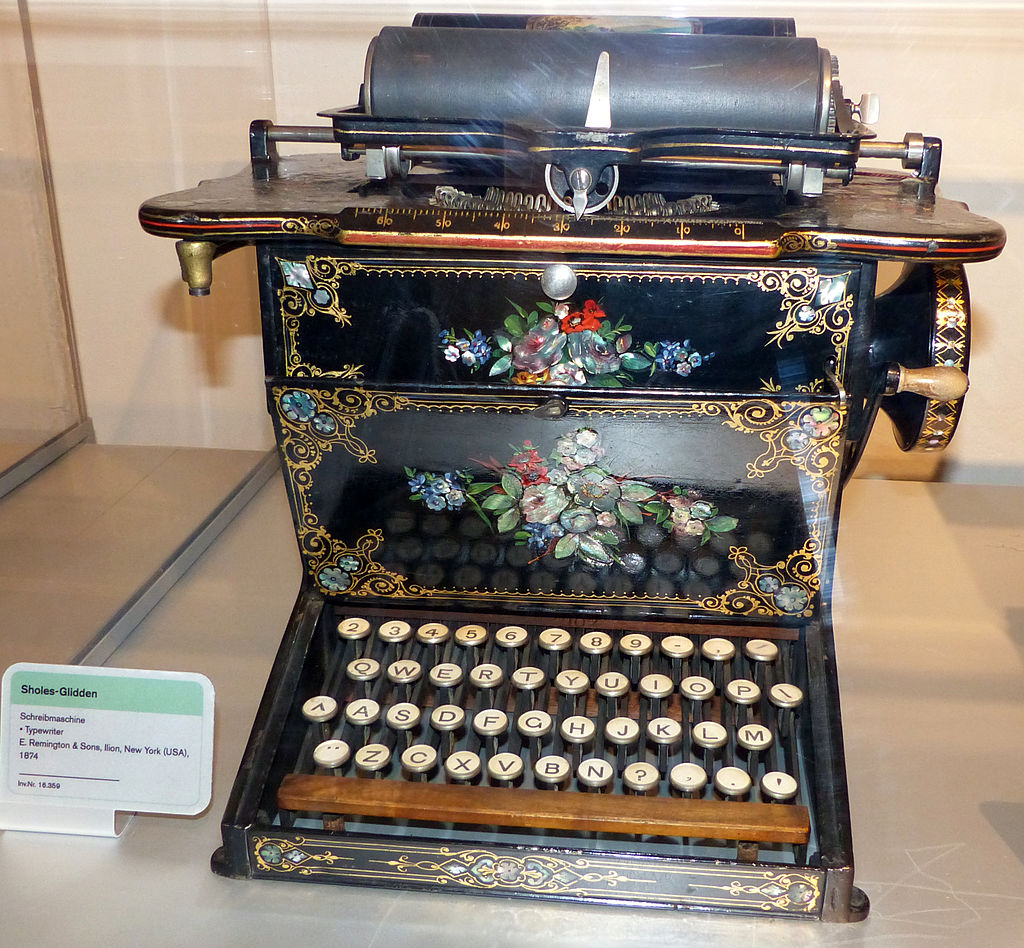Why can not we abandon the QWERTY-keyboard
- Transfer
We have been using it for printing for 144 years already. Why it works, and what will make us abandon it.

Tap is a device for one hand, putting on it like rubber brass and connecting wirelessly with a smartphone. It should free you from clumsy physical keyboards and work as a printing interface, which is always with you. In the commercial, we see people smiling people wearing Tap, and typing text, typing with one hand, anywhere - on the leg, on the arm, and even (perhaps it's a joke) - on some guy's forehead.
It seems like a great idea, huh? But when I tried to use this gadget, the reality was neither fun nor interesting. Unlike the usual QWERTY keyboard, Tap demanded constant thinking from me - I had to move my fingers extremely intuitively to enter letters: A - thumb, B - index and little finger, C - all fingers except index ...

I remembered these combinations, playing simple games to choose letters in the application, but it was very tiring. Typing on the thigh was almost impossible - just like on any other surface except smooth and firm. My most verbose tweets consisted of several words, and it took me several minutes to write them. Even typing a word like “Aha!” I felt uncomfortable and uncomfortable. Not having lasted a week, I gave up, and returned to my big old-fashioned QWERTY-keyboard and to her soothing tactile feedback.
But although I didn’t work out with Tap, it raises an important question about the evolution of technology. We have so many data entry methods - by voice, via touch screen, stylus, etc. - and yet we still rely on technology that is very much like the first commercially successfultypewriters that appeared almost 150 years ago. We can create powerful computers that fit in your pocket. So why we did not give up the keyboard?
Freaky QWERTY Story
Partially the answer lies in inertia. You learned to type on a big clumsy keyboard, like your parents, and grandparents (and maybe great-grandparents with great-grandmothers). It's comfortable; Kevin Weaver, a professor of physiotherapy at New York University, said she currently has got rid of all potentially unpleasant ergonomic problems.
“We’re stuck in a cycle,” says Frank Jones, associate professor of computer science at Birgam Young University, creator of the finger-tracking keyboard for DotKey touch screens . - We teach children to use QWERTY, because it is ubiquitous. Why QWERTY is Ubiquitous? Because we teach children to use it. ”

Dotkey
But it was not always so. Early typewriters showed all sorts of options for creative layouts and the location of the keys. However, the layout of the Sholes & Glidden Type-Writer typewriter , developed by and large by a Wisconsin-based inventor named Lethem Christopher Scholes, which was engaged in the sale of E. Remington & Sons weapons manufacturer since 1874, has been fixed .
The Sholes & Glidden typewriter became the first popular typewriter, and its layout almost coincided with the QWERTY we used today. She typed in extremely large letters, so reading Scholes' early letters created the impression that the other person was yelling at you.

It is not clear exactly how Scholes came up with the layout of the keys specified in the patent of 1878, although there are plenty of theories on this subject. He had experience in the printing industry and published a newspaper, so he should have known how typesetters organize their trays with letters by frequency of use.

In 2011, researchers at Kyoto University suggested that the QWERTY layout was due to a rearrangement of letters that was supposed to suit early clients: telegraph operators who used it to record messages encoded in Morse code. (For example, some letters that are often confused with each other in Morse code are located quite close to each other on the keyboard). Researchers challenged the popular version of the popular origin of QWERTY, according to which this layout was supposed to prevent the mechanism from getting stuck when people pressed keys one after another, which were often letters, too quickly. One way or another, but in 1893 several large manufacturers of pismashynok united and formed a united company Union Typewriter Company.
Some time passed before the children began to study this layout . Today in the US, children should be able to type on the keyboard for the third grade , and in some schools children are taught this at the kindergarten age .
QWERTY dominates not only in countries where the alphabet is used (with small local variations), but also in countries like China that have developed their own systems, such as pinyin , for typing a huge number of characters on one simple keyboard.
But the success of the QWERTY keyboard cannot be attributed to the lack of competition.
Rivals
Long before Tap, many attempts were made to change the layout and shape of the keyboard - for example, Dvorak's keyboard , patented in 1936 by Professor at the University of Washington Augustus Dvorak. From more modern attempts, you can select the Twiddler one-handed keyboard . None of them could make a dent in the dominance of QWERTY.

And then there were mobile phones. This led to large changes in typing — first, using T9 on the buttons, where there were three to four letters to one number; then small BlackBerry-style keyboards; and now touchscreens. Still, you’re probably referring to a large physical QWERTY keyboard for typing something more than a small letter. And on-screen keyboards are mostly scaled versions of QWERTY.
But this does not stop various companies, from giants like Facebook to unknown entrepreneurs, from trying to improve or replace this layout. Tap creator Dovid Shik, for example, is convinced that as computers become more mobile, wearable and touch-sensitive, and the popularity of virtual and augmented reality grows, we will need new ways to enter words into the machine.
Chic with partner (and wife) Sabrina Kemeny created Tap, which uses accelerometers for each finger, which can turn various keystrokes into letters and punctuation. To decide which finger combination to assign which letter, they studied ergonomic research and the frequency of letters.
Chic imagines Tap - which costs $ 179, which is much more than an average keyboard - as a tool for all kinds of people. People with vision problems can use it to facilitate interaction with a smartphone, he says, and he can imagine using it for languages like Chinese. The TapMapper application allows users to independently create layouts for Tap.
Despite the complete failures of other alternative keyboards (including one very similar to Tap called Gest ), he doesn’t lose heart at all. “There is no doubt that the QWERTY keyboards will look ridiculous as a result,” he says.
Weaver, a physiotherapy teacher, agrees with him. But he is not sure that the transition from them will occur to hand-held devices like Tap. Firstly, such devices can cause even more fatigue, since they do not have such a ratio of "one finger per one key", to which many are accustomed. And, as he says, "this thing doesn't look practical." After a few days of messing around with Tap, I probably agree.

Radical change
At the headquarters of Logitech, the largest keyboard manufacturer in Lausanne, Switzerland, Art O'Gnim spends a lot of time thinking about what changes might make sense. This company, which sells more than 30 million keyboards a year, has “healthy paranoia” about how we will express ourselves in the future, he admits.
O'Gim is the head of the Logitech keyboard and mouse business. Ihoti he believes that this device will be popular for many years (which is not surprising), he also believes that other technologies, for example, software for predictive dialing, will make it less important. For example, Gmail features such as Smart Compose and Smart Reply offer simple (and sometimes unintentionally funny) automatic email and reply options.
But if anything convinces us to give up or significantly change the QWERTY keyboard, he will need to seriously improve our way of communicating. He will need to organize input in a faster and smarter way, without forcing us to spend a lot of time learning something new.
What about voice input? It is often found on smartphones, and recently has become quite accurate. However, it cannot become the future for serious input of texts - because, for example, it is absolutely not secretive.

And what if there are no input interfaces at all in the future? Neurable - a startup from Cambridge in pcs. Massachusetts working on a way to print by power of thought. It uses a bezel littered with electrodes, connecting with virtual reality glasses and tracking brain activity. Machine learning helps you understand which letter you want to choose and predicts which one you will need later. After choosing a few letters, he can finish the end of the word, says one of the founders and director of the company, Ramses Alcade.
Neurable aims at a speed of about 14 words per minute, Alcade says, which he believes will be enough to send quick messages. It is suitable for transmitting very simple thoughts in cases where you do not want to use your hands or voice - and agree to wear a headband with electrodes on your head. Perhaps it will be useful, but the keyboard does not kill such a thing.
Then, there is another device created by CTRL-labs : this is a bracelet that recognizes the activity of the muscle fibers of the hand. It, for example, can be used to replace game controllers. Another option is to use algorithms that recognize what you are trying to type, even if your hands are barely moving.


The director and one of the company's founders, Thomas Reardon, who previously created Microsoft Internet Explorer, says that this is also a kind of neural interface. Whether you type or dictate, you use your brain to turn muscles on and off, he says.
Reardon says that the CTRL-labs bracelet can adapt to the user's typing style, and not make it adapt to a physical or virtual keyboard. He, for example, has a bad pinky, which makes it difficult for him to type the letter “p” on a typical QWERTY keyboard. His system solves this issue by changing the layout of the movements depending on his style of printing. As a result, when using the bracelet CTRL-labs, you can write letters with very weak movements.
However, Reardon, like other people working on keyboard substitutes in the distant future, does not say when the device will be available to everyone. It is planned that the developer version will arrive at the end of this year, but although it will be able to perceive hand and finger movements based on muscle contraction, it will not have such a function as printing based on this data.
More significantly, he admits that the device is not yet good enough for him to discard his model of the mid-80s IBM Model M, which, as he says, “still sounds like peals of thunder” when typing.
Still click

Perhaps our children will no longer depend on QWERTY keyboards, like us. But they will use them, because against the background of all the alternatives, the familiar keyboard actually does its job well. And in a world where technology often becomes intangible, it is pleasant — and even meditative — to have a physical object at hand that can be touched and used for printing. This is definitely nicer than waiting patiently for a few words to leak through the rim of thought that reads on your head, or to try to translate thoughts from your head to the screen in front of you with a rubber pair of brass knuckles.
